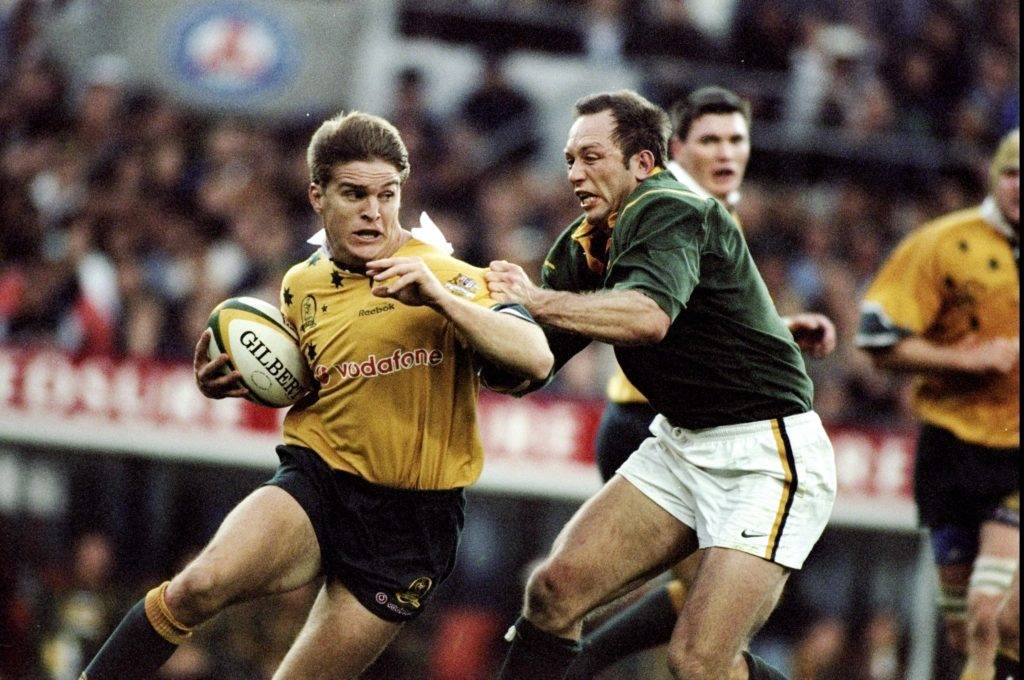In the second instalment of a seven-part series, SA Rugby magazine’s writers pick their best World XV of the past 25 years.
JON CARDINELLI: Tim Horan had it all – the step, the speed and the vision to put his outside backs away. While he made a name for himself during the latter days of the amateur era, it was at the 1999 World Cup where the Wallabies magician was at his very best. Horan starred in the semi-final against the Springboks and was named Man of the Tournament after Australia won the World Cup.
I found it hard to settle on an outside centre. There have been so many great performers in this position over the past 25 years – Jaque Fourie, Brian O’Driscoll and Jonathan Davies to name a few. None made as big an impact as Conrad Smith did for New Zealand, though, over a period of 11 years.
‘The Snake’ was a nightmare to defend against. Smith was perhaps better known among players and coaches for his ability to organise his own side’s defence from that No 13 position. He was a key man for the team that went on to win back-to-back World Cups – a team which will be remembered by many as the greatest in the history of the sport.
OUR SPRINGBOK XV: The final squads
CRAIG LEWIS: This is tough. I could go round and round in circles trying to select my centres, with simply too many greats to choose from.
So, I’m simply going to go with my gut. At inside centre the first name that comes to mind is Ma’a Nonu. In his prime, the All Blacks World Cup winner was simply a machine. Towards the end of his career he also added some subtlety to his game, but it was his physicality that always remained his most fearsome quality.
Of course, the temptation is to pick him in tandem with his long-time All Blacks midfield partner, Conrad Smith, but again my gut instinct says go with Jaque Fourie. He was undoubtedly one of my all-time favourite Springboks, and having picked four New Zealanders already, it’s about time I got my first Saffa in there before I am lynched by the rugby trolls.
FROM THE VAULT: Burger battles back from the brink
WADE PRETORIUS: I was desperate to select French great Philippe Sella but the rules of this selection state ‘the best of the last 25 years’ … My centre pairing seemed a lot easier, after my Sella conundrum, to pick Ma’a Nonu at 12 and Brian O’Driscoll outside him.
There was nothing Nonu couldn’t do and to keep your place in the All Blacks side for so long speaks volumes. He ended as a double World Cup winner with a fierce reputation as a defender and explosive ball-carrier.
O’Driscoll was the standout Irishman for a decade plus and was another known for his defensive steel. That’s not to say he wasn’t one of the best 13s with ball in hand, though. With the most tries in the clover green of his home nation and most appearances as captain, there was never any doubting his class or his consistency.
COVID-19: How rugby has been affected
MARIETTE ADAMS: I have to second Craig Lewis here: selecting a midfield duo is difficult. The game has been blessed with wonderful centres in both its amateur and professional eras.
Ultimately, I decided on Tim Horan at inside centre with Brian O’Driscoll playing on his outside.
Horan was a power-packed runner with great balance, but what enhanced his greatness was that he was just as sharp in defence as on attack. Throughout his illustrious career, Horan was one of the most feared players in the game. And something I’ve just learned about him … Horan did not play a single Test as a substitute. He was capped 80 times by the Wallabies and started in every one of those matches.
Additionally, Horan is one of a rare group of players who not only played in three different World Cups but also won it twice (1991, 1999).
O’Driscoll’s Test statistics are equally impressive. He played 141 Tests (133 for Ireland and eight for the British & Irish Lions) and only once featured as a substitute. He was renowned for his out-and-out pace, but O’Driscoll still quite possibly rates as one of the top-three best defensive centres ever. His desire to always be involved made him a menace at the breakdown and somewhat of a turnover king.
The staggering thing about O’Driscoll is that he suffered from astigmatism, a condition which left him with only 50% of the average person’s vision. And that makes his career all the more remarkable.
DYLAN JACK: There are far too many world-class centres to pick, so I am going to have to go for combination.
On that basis, I select the centre pairing that helped the All Blacks claim their second and third World Cups in 2011 and 2015. As a pair, there were few as deadly as Ma’a Nonu and Conrad Smith.
Nonu brought the muscle, the intial blockbusting of a team’s defence. While he was far more subtle towards the end of his career – adding a little bit of a kicking game to his repertoire – he was still feared for what he could do when running at a defence.
Smith, meanwhile, was more of a cerebral player – feared as much for his organisation of his team’s defence as their attack. Together the two played a record number of times together and formed the basis of one of the greatest Test teams in history.
Photo: Dave Rogers/ALLSPORT





